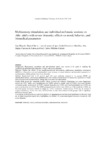Mostrar o rexistro simple do ítem
Multisensory stimulation and individualized music sessions on older adults with severe dementia: effects on mood, behavior, and biomedical parameters
| dc.contributor.author | Maseda, Ana | |
| dc.contributor.author | Cibeira, Nuria | |
| dc.contributor.author | Lorenzo-López, Laura | |
| dc.contributor.author | González-Abraldes, Isabel | |
| dc.contributor.author | Buján, Ana | |
| dc.contributor.author | Labra, Carmen de | |
| dc.contributor.author | Millán-Calenti, José Carlos | |
| dc.date.accessioned | 2018-07-02T10:07:12Z | |
| dc.date.available | 2018-07-02T10:07:12Z | |
| dc.date.issued | 2018 | |
| dc.identifier.citation | Maseda A, Cibeira N, Lorenzo-López L, González-Abraldes I, Buján A, Larbra C, et al. Multisensory stimulation and individualized music sessions on older adults with severe dementia: effects on mood, behavior, and biomedical parameters. J Alzheimers Dis. 2018;63(4):1415-1425 | es_ES |
| dc.identifier.issn | 1387-2877 | |
| dc.identifier.issn | 1875-8908 | |
| dc.identifier.uri | http://hdl.handle.net/2183/20833 | |
| dc.description.abstract | [Abstract] Background:Multisensory stimulation and individualized music have shown to be good in handling the psychological and behavioral symptoms in people with severe dementia. Objective:Explore the effects of two nonpharmacological interventions, multisensory stimulation environment (MSSE) in a Snoezelen room and individualized music sessions, on mood, behavior, and biomedical parameters of institutionalized elderly patients with severe dementia. Methods:Randomized trial of 21 patients aged ≥65 years randomly assigned to two groups (MSSE and individualized music). Interventions administered in two-weekly sessions lasted 30 minutes for a period of 12 weeks. Main outcomes were recorded before, during, and at the end of the intervention. Results:Both groups had immediate positive effects on mood and behavior. Participants were more happy/more content (p < 0.001), talked more spontaneously (p = 0.009), related to people better (p = 0.002), were more attentive to/focused on their environment (p < 0.001), enjoyed themselves (p = 0.003), were less bored/inactive (p = 0.004), and more relaxed/content (p = 0.003). The MSSE group performed a better visual follow-up of the stimuli (p = 0.044), and the music group were more relaxed and happy (p = 0.003). A decrease in heart rate (p = 0.013) and an increase in oxygen saturation (p = 0.011) were observed from before to after interventions in both groups, with no significant differences between them. Conclusions:Both interventions seem to be effective at managing mood and behavioral disturbances in the short term and at improving physiological rates, highlighting the efficacy of nonpharmacological treatments in patients with severe dementia. | es_ES |
| dc.description.sponsorship | Galicia. Consellería de Cultura, Educación e Ordenación Universitaria; ED431C 2017/49 | es_ES |
| dc.description.sponsorship | Galicia. Consellería de Cultura, Educación e Ordenación Universitaria; IN607C | es_ES |
| dc.language.iso | eng | es_ES |
| dc.publisher | IOS Press | es_ES |
| dc.relation.uri | http://dx.doi.org/10.3233/JAD-180109 | es_ES |
| dc.rights | The final publication is avaliable at IOS Press Content Library | es_ES |
| dc.subject | Dementia | es_ES |
| dc.subject | Elderly | es_ES |
| dc.subject | Individualized music | es_ES |
| dc.subject | Randomized trial | es_ES |
| dc.subject | Snoezelen | es_ES |
| dc.title | Multisensory stimulation and individualized music sessions on older adults with severe dementia: effects on mood, behavior, and biomedical parameters | es_ES |
| dc.type | info:eu-repo/semantics/article | es_ES |
| dc.rights.access | info:eu-repo/semantics/openAccess | es_ES |
| UDC.journalTitle | Journal of Alzheimer's Disease | es_ES |
| UDC.volume | 63 | es_ES |
| UDC.issue | 4 | es_ES |
| UDC.startPage | 1415 | es_ES |
| UDC.endPage | 1425 | es_ES |
Ficheiros no ítem
Este ítem aparece na(s) seguinte(s) colección(s)
-
INIBIC-IX - Artigos [31]






